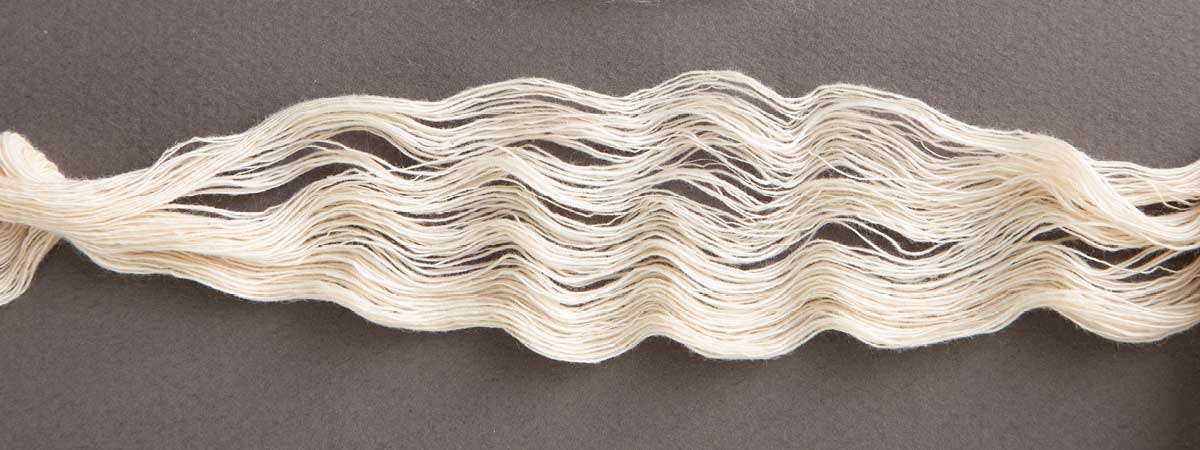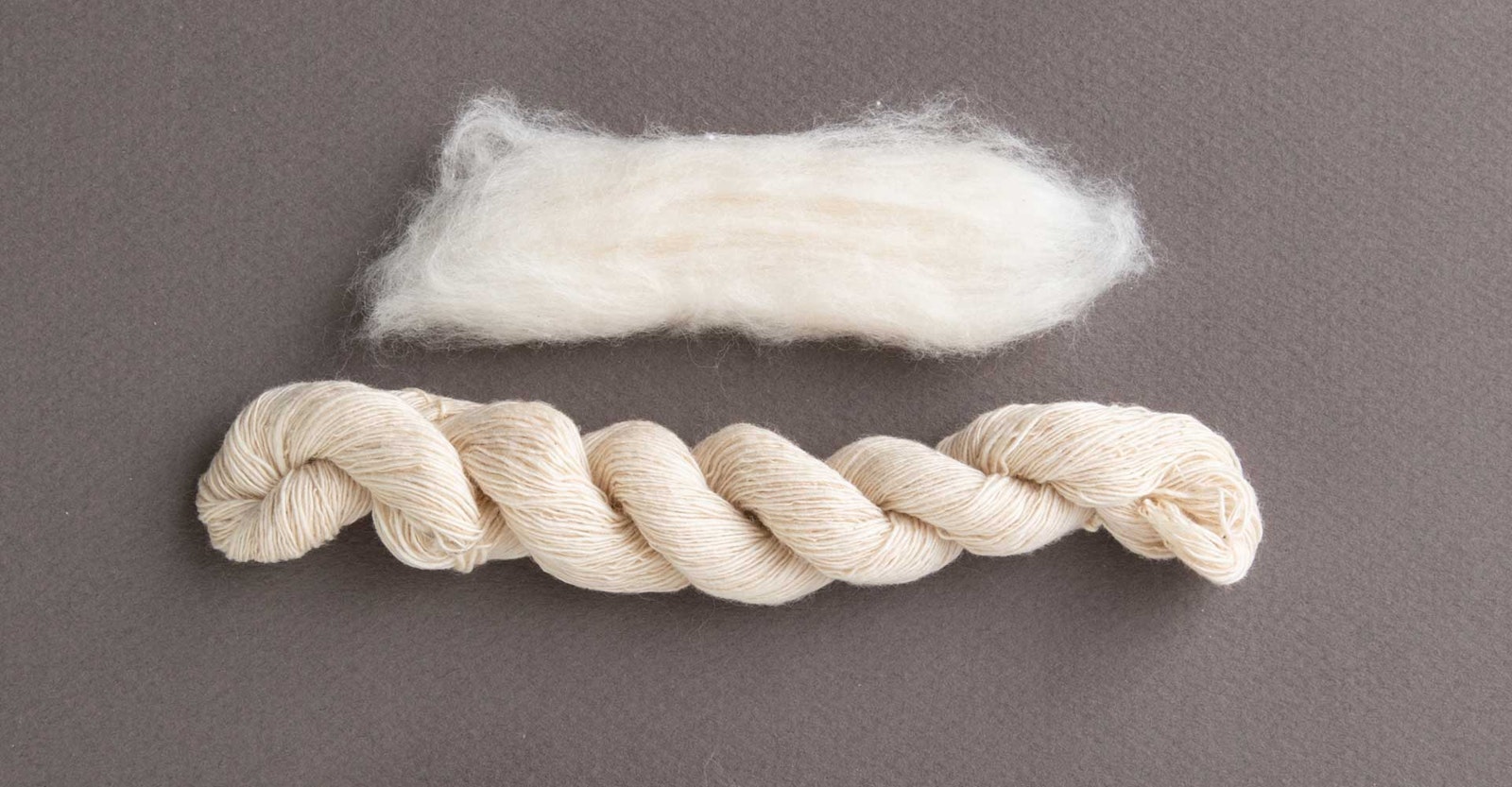Archaeological evidence indicates that cotton has been cultivated, harvested, and spun for thousands of years. Finds in Mexico dating from 5000 BCE, in the Indus Valley dating from 3000 BCE, and in other regions show that cotton was harvested and spun in different parts of the globe.
Sea Island Cotton
Sea Island cotton is a New World barbadense cotton. In 1492, Christopher Columbus landed on Hispaniola and saw cotton growing there. It was unlike the Old World cottons he knew back home. This New World cotton fiber was long (1¾ to 2¼ inches), lustrous, strong, and very fine. Columbus, a weaver’s son, brought home cotton treasures he found in the New World.
Long-staple Sea Island cotton takes its name from the band of barrier islands off the coasts of the Carolinas and Georgia. It was grown on the barrier islands until it was decimated by the boll weevil in the late ninteenth and early twentieth centuries. It also grew (and still grows today) on several Caribbean islands such as Jamaica, Antigua, Anguilla, Nevis, St. Kitts, and Barbados. Because its seeds have a dark, slick, hairless surface, it is also known as “black-seed cotton.”
The Story Continues: Pima Cotton
Pima has a labyrinthine heritage. When Sea Island barbadense seeds from the New World were brought to the Mediterranean area as ornamentals, a new story begins. The Sea Island plants apparently hybridized readily with an Old World arboreum, a tree cotton that produced a long, strong cotton fiber with a slick seed. This Mit Afifi (sometimes Mit Affifi) cotton became the progenitor for a series of strong, long-stapled Nile Delta cottons often referred to as Egyptian cotton.
After the boll weevil decimated the Sea Island cotton industry in the late nineteenth and early twentieth centuries, the search for an alternative began. Seeds from Egyptian Mit Afifi were planted in Yuma, Arizona, and seeds from two extraordinary plants were chosen to become the Yuma variety. Nine years later, a single outstanding plant was selected to be a new cultivar that would later be known as Pima cotton.
Remarkably, this Egyptian cotton with barbadense genetics had made the return trip across the Atlantic, with intent to acclimatize a tropical plant to warm but drier conditions. Far from the warm tropics, a long, strong white cotton blooms with Sea Island heritage: Pima.

Sea Island cotton is usually combed due to its long staple length. Stephenie says that the Sea Island sliver available to spinners often doesn’t exhibit the extreme staple length Sea Island cotton plants can produce. However, this rare and silky fine fiber is a delight to spin.
A Spinner’s View of Sea Island Cotton
My best advice is:
1. Keep your hands out of it.
2. Spin fine.
Sea Island is a fine fiber probably right up there with some cashmere fibers. It wants to be spun as teeny-weeny, fine, delicate yarn. I encourage you to avoid pushing it to spin heavier, as it’s tough to maintain a larger-gauge singles that is consistent.
The staple of Sea Island cotton is longer than Upland cotton (Gossypium hirsutum), another type of New World cotton. Upland cotton could be called the down-breed wool of the cotton world, whereas Sea Island would be comparable to cashmere. But the real difference is in Sea Island’s silkiness. It drafts swiftly, gracefully, and freely into a fine yarn. Once the twist is buried in the fiber, it easily crushes the loft out of the yarn. If you break the singles as you spin, tear off the mangled end, find a brushy, lofty section of the singles to join your fiber, and begin your draft again.
A cautionary note: Ordinarily, cotton hates to be petted, stroked, fondled, compacted, or pressed between fingers. Sea Island rebels and goes sullen with this treatment. If you really must, sacrifice a few inches of sliver to exploring and get it out of your system. Then use a light touch as you spin the rest.
Carded slivers are directional. They spin better from one end than the other, and Sea Island is adamant. One end will slither smoothly and the other will burp slubs. If you are having trouble drafting, simply try the other end.
Spinning Sea Island cotton is literally touching the past. This is a textile fiber with few equals. The buttery smooth coolness of Swiss cottons is the product of Sea Island cotton, as are fine lawns and handkerchief cottons that are so sheer that you can read a newspaper through them.
For better than 40 years, Stephenie Gaustad has taught classes in spinning, weaving, and dyeing. Her articles have appeared in Handwoven; Shuttle, Spindle & Dyepot; Spin Off; PLY; add space and more. Her replicate textiles hang at the Pueblo Grande Museum in Phoenix, Arizona. She illustrated The Alden Amos Big Book of Hand Spinning, and her most recent book, The Practical Spinners Guide to Cotton, Flax, and Hemp, was released in 2014.
Resources
Crawford, Morris De Camp. The Heritage of Cotton. New York and London: G. P. Putnam’s Sons, 1924.
Hamby, Dame Scott, ed. The American Cotton Handbook: A Reference and Text for the Entire Cotton Textile Industry, Vol. 1. New York: Interscience, 1965.
HipStrings Modern Fiber Arts, www.hipstrings.com
Lunatic Fringe Yarns, www.lunaticfringeyarns.com
Matthews, J. Merritt. The Textile Fibres. London: John Wiley & Sons, 1913.
Mielke’s Fiber Arts, www.mielkesfiberarts.com
Porcher, Richard Dwight, and Sarah Fick. The Story of Sea Island Cotton. Salt Lake City, Utah: Gibbs Smith, 2010.
Tortora, Phyllis G., and Robert S. Merkel. Fairchild’s Dictionary of Textiles. New York: Fairchild, 2010.

